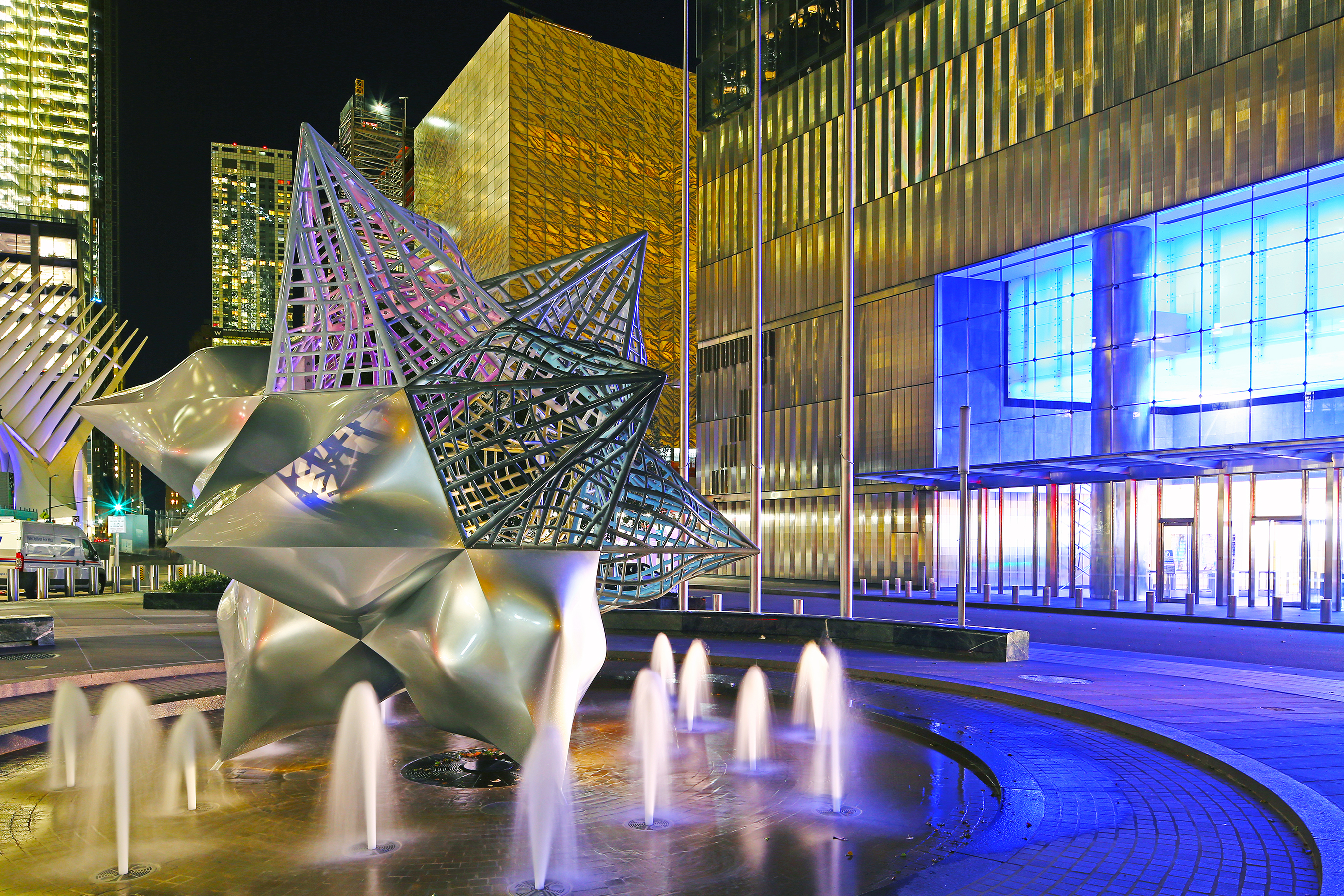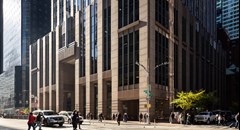By Emily Murphy | 6sqft
While the Financial District, located at the southern tip of Manhattan, maybe most closely synonymous with Wall Street and towering office buildings, it is also home to world-class museums, public art installations and performances, and unexpected treasures that make it a worthy destination for art lovers. Better yet, during a time of increasing unknowns and fluctuating Covid statistics, many of FiDi’s cultural elements can be safely experienced outside or at a distance. From large-scale sculptures to a landlocked lighthouse, here is the ultimate art lover’s guide to FiDi.
Battery Park City
Battery Park City, on the western side of FiDi, encompasses 36 acres of public parks and plazas. The Battery Park City Authority, responsible for managing the area, is also dedicated to the installation and upkeep of a world-renowned collection of 20th- and 21st-century sculptures. While there are nearly 20 permanent sculpture installations throughout Battery Park City, there is also a constant stream of new art installed on a temporary basis throughout the park space.
“Every two years, one or more artists, either emerging or well-established in their careers, install their artwork for temporary and free exhibition in popular public locations across Battery Park City,” explains B.J. Jones, president & CEO of the Battery Park City Authority.
“The locations are chosen together by artists and the BPCA public art management team for optimum visibility and accessibility, and with sensitivity for public comfort to extend the experience with the art such as shade, seating, and signage with artist’s statements, as well as free tours, talks, and creative workshops…The role of public art within the greater neighborhood is considered a vital part of a free and aware society; our guiding lights are inclusivity, untold histories, and participatory enjoyment. BPCA is honored to continue a legacy of presenting meaningful art for all to enjoy.”
Group of Four Trees by Jean Dubuffet
Originally commissioned in 1969 by David Rockefeller, then Chairman of Chase Manhattan Bank, Jean Dubuffet’s Group of Four Trees still stands sentry outside of One Chase Manhattan Plaza. Evocative of Dubuffet’s signature style, the abstracted black, and white trees sit in stark contrast to the surrounding corporate offices. The swirling black lines and incongruent composition of the 40-foot work bring a welcome whimsy to an otherwise sterile section of town.
Red Cube by Isamu Noguchi
Just in front of Zuccotti Park–a small gathering space made famous during the Occupy Wall Street protests–is Isamu Noguchi’s Red Cube. This monumental sculpture of a cube tilted on its axis is a bright red splash amidst the monochromatic color of the surrounding buildings. More works of Noguchi’s can also be seen scattered throughout NYC, including at the Metropolitan Museum of Art, Rockefeller Center, and even around the corner from Red Cube at Chase Manhattan Plaza, where the artist installed Sunken Garden, a zen garden composed of 27,000 stones.
Zuccotti Park
Just past Red Cube, there are several sculptures installed within Zuccotti Park. Mark di Suvero’s soaring Joie de Vivre became infamous when an Occupy Wall Street protestor climbed to the very top and stayed for several hours until the police escorted him down. Other works of art on permanent public display include Double Check, a bronze sculpture of a businessman by John Seward Johnson II, and Rose III by Iza Genzken, a 26-foot tall steel rose with a twin at the Museum of Modern Art.
Louise Nevelson Plaza
Located between Liberty Street and Maiden Lane, Louise Nevelson Plaza, named after famed artist Louise Nevelson, is a small public space featuring several of Nevelson’s signature sculptures. Entitled “Shadows and Flags,” these six works of art were crafted from Cor-Ten steel and painted black. When seen together, they are meant to represent abstract expressions of the flags, spirals, and structures that define New York City’s skyline.
Thierry Noir’s Berlin Wall
Years after the 1961 construction of the Berlin Wall, French artist Thierry Noir decided to begin painting sections of it, covering the west facade in cartoonish, brightly painted heads. After the wall fell in 1989, pieces of the original concrete with Noir’s paintings were gifted to various cities across the world. On South End Avenue, just west of the World Trade Center Memorial, one section is on display. The face represented is immediately recognizable as Noir’s, and is a reminder of the power of art to invoke change. Additional sections of the wall can be seen in other neighborhoods throughout the city.
Frank Stella’s Jasper’s Split Star
20 years after two of his paintings were destroyed on 9/11, legendary artist Frank Stella has returned to Ground Zero with the monumental sculpture Jasper’s Split Star. The piece – a 12-point star rendered in aluminum and bright colors – was installed at the Silverstein Family Park at 7 World Trade Center in November of 2021. While this work is the private property of developer Larry Silverstein, it is accessible to the public in the space outside one of Silverstein’s buildings and is a wonderful representation of Stella’s signature star motifs. Its installation is also a testament to the resiliency and resurgence of this downtown neighborhood in the wake of the devastating terrorist attacks of 2001.
Public programming & residencies
Another key component of FiDi’s artistic core is the Lower Manhattan Cultural Council. Founded in 1973, LMCC grants about $1.5 million a year to independent artists and creators, making them the city’s largest regrantor of public art funding. LMCC also offers residencies, public programming, and produces the annual River to River Festival. In addition to the organization’s annual programming, their grantees also perform publicly at venues and open spaces around lower Manhattan.
At various times throughout the city’s history, LMCC has worked to revitalize downtown neighborhoods through art. “We’ve done that through putting art directly where someone would stumble across it,” Ana Fiore, LMCC’s Director of Artist Services, said.
“We’re really dedicated to using unconventional and surprising spaces and making it something folks can seek out but also something people will stumble upon and be able to have an artistic experience that they weren’t expecting. We use public parks but also small streets and alleyways, all sorts of spaces throughout lower Manhattan as a way to integrate art into the day-to-day experience.”
Charging Bull and Fearless Girl
While Arturo di Modica’s Charging Bull statue has been a staple of Wall Street and a symbol of financial optimism since the 1980s, Kristen Visbal’s Fearless Girl is a newer addition to the downtown landscape. When Fearless Girl was first unveiled in 2017, it stood just feet from the 7,100-pound bull, as if facing it down, a bronze representation of female empowerment. Fearless Girl was ultimately moved in front of the New York Stock Exchange where its future remained uncertain, as the work never had a permit for a permanent exhibition. In a unanimous vote in December, the Landmarks Preservation Commission said the 4-foot-tall statue could remain outside the NYSE for another three years. The final decision will be made by the Public Design Commission at a hearing set for sometime this year.
Museum of Jewish Heritage
Described as a living memorial, the Museum of Jewish Heritage educates visitors on Jewish life before, during, and after the Holocaust. In addition to its permanent collection and engaging programming, the museum also hosts exhibitions that highlight the work and stories of Holocaust survivors, many of which include paintings, drawings, sculptures, and writings.
National Museum of the American Indian
The National Museum of the American Indian has a collection that is so extensive, it is spread between three sites. In New York City, the Lenape homeland of Lenapehoking, the downtown site is dedicated to exhibition and education facilities. While the building itself, the historic Alexander Hamilton U.S. Custom House, is alone worth examining, the museum also presents in-depth exhibitions and programming that explore the diversity and culture of the indigenous peoples of the Americas through fine art, dance, music, and more.
South Street Seaport Museum
As Manhattan is an island, its waterways are of the utmost importance. At South Street Seaport Museum, visitors can view art and artifacts related to New York City’s history as a major international port. An extensive collection of drawings, watercolors, paintings, tools and more preserves the city’s maritime history. Along with the permanent collection, there are also quirky elements to experience like the landlocked lighthouse that is a memorial to the victims of the Titanic, and the opportunity to sail New York’s harbors on an authentic 1885 schooner.


